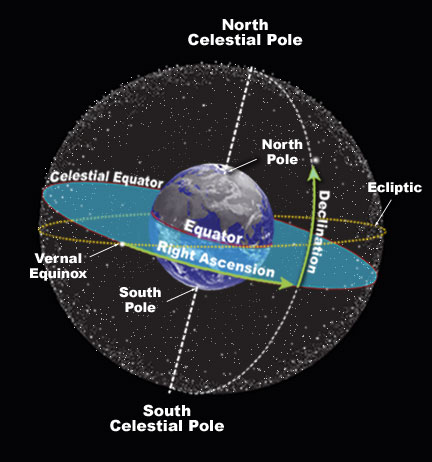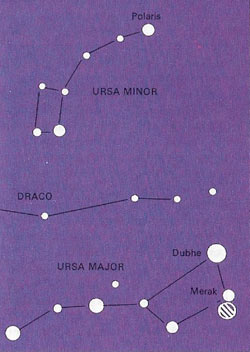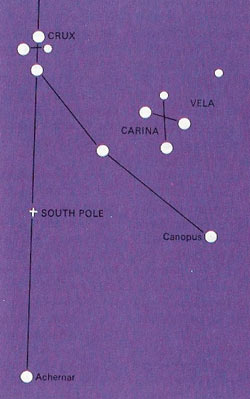celestial sphere

The celestial sphere is the imaginary sphere upon whose inner surface celestial objects can be considered to lie for the purpose of describing their position. The celestial sphere is centered on the origin of whatever system of celestial coordinates is being used.
Celestial axis and celestial poles
The celestial axis is the projection of Earth’s rotation axis, north and south, onto the celestial sphere. The celestial poles are the two points where an extension of Earth’s axis intersects the celestial sphere and about which the celestial sphere appears to rotate daily. As a result of precession, the celestial poles complete a circle around the ecliptic poles every 25,800 years.
 |
| The north celestial pole is easy to find because Polaris (the North Star) lies within one degree of it. Polaris can be found by following the line of the Pointers, Merak and Dubhe, in the Great Bear. As Earth rotates from west to east, the celestial pole remains stationary while all other objects appear to circle it slowly. Depending on the position of the observer, the Pole Star will be in a different area of the sky; only at the North Pole is it seen directly overhead. As the celestial pole is thus an extension of Earth's axis, so also is the celestial equator a projection of Earth's equator. A star at the celestial equator will rise in the east and set in the west 12 hours later.
|
 |
| The south celestial pole is more difficult to locate than its northern counterpart. There's no convenient south polar star; the south south celestial pole lies in a barren region made of the faint constellation Octans. The best way to locate the pole is to follow the longer axis of Crux to the point about midway between Crux and the bright star Achernar, in the constellation Eridanus. The nearest naked-eye star to the pole is the fifth-magnitude Sigma Octantis.
|
An hour circle is a great circle on the celestial sphere that passes through a celestial object and the north and south celestial poles. Everywhere on an hour circle the right ascension is the same.
Celestial meridian and celestial equator
The celestial meridian is the great circle on the celestial sphere that passes through the celestial poles and the zenith of the observer. The celestial equator is the great circle on the celestial sphere that divides the northern and southern hemispheres and serves as the zero-mark for declination; it is the projection into space of Earth’s equatorial plane.
Celestial latitude and longitude
The celestial latitude is the angular distance on the celestial sphere measured north or south of the ecliptic along the great circle passing through the poles of the ecliptic and the celestial object. The celestial longitude is the angular distance along the ecliptic from the vernal equinox eastward.
Vertical circle
A vertical circle is a great circle of the celestial sphere, passing through the zenith and nadir. Vertical circles are perpendicular to the horizon. The prime vertical circle or prime vertical passes through the east and west points of the horizon. The principal vertical circle passes through the north and south points of the horizon and coincides with the celestial meridian.


